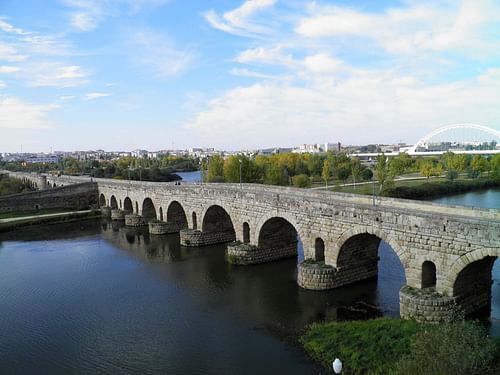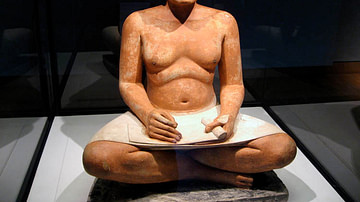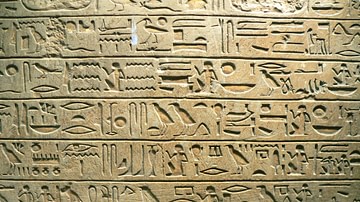The legacy of the ancient Romans – from both the time of the Roman Republic (509-27 BCE) and the time of the Roman Empire (27 BCE - 476 CE) – exerted a significant influence on succeeding cultures and is still felt around the world in the present day. Roman inventions or innovations were so effective that they either continued in use or were later rediscovered to serve as models in virtually every aspect of human society from the mundane to the sublime. These aspects include but are not limited to:
- Government
- Law
- Technology and engineering
- Cultural transmission and adaptation
- Public servants
- Commerce and customer service
- Cuisine and fast-food
- Dog breeding, training, and collars
- Military & religious organization
- Language & leisure activities
At its height, c. 122 CE (under the reign of Hadrian, 117-138 CE), the Roman Empire stretched from Europe through North Africa, Asia Minor, and Mesopotamia and the Romans left their mark on the regions they had held long after the Western Empire had fallen. In some regions, such as Britain, the value of Rome's legacy was not immediately appreciated and was only realized later while in others, such as Greece and Italy, it was embraced earlier. After the Renaissance, in the 16th century CE, with the rediscovery of classical works, more nations recognized the value of Roman culture and came to adopt aspects of it in developing their own culture and traditions.
Government
One of their most impressive contributions is in the separation of the government's branches – executive, legislative, judiciary – so that no one branch held exclusive power and each provided a check and balance to the others. The Romans had deposed their king in 509 BCE and wanted to protect their new form of government from the kind of tyranny they had endured under the monarchy. The executive branch of Rome during the Republic was the consuls, the legislative was the assemblies who made the laws and the Roman Senate which decreed them, and the judges were the judiciary. The people's assembly served to vote for the consuls in the same way common people vote for elected officials in the present day. During the Empire, the executive branch was the Roman emperor, the legislative was the assemblies/Senate, and the judiciary remained the judges. Although Athens, Greece is the birthplace of democracy, Rome was where that concept developed. This model of government and the concept of a democratic, representative republic would later be adopted by the United States of America.
Law
The concept that everyone was subject to the law equally no matter their social class is also a Roman innovation as is trial by jury, civil rights, personal wills, and business corporations. The Twelve Tables addressed specifics of the law as well as penalties. The Twelve Tables were expanded under the reign of Justinian I (527-565 CE) into 50 books of law known as the Pandects but better known today as the Roman Digest which was lost with the fall of Rome and only discovered in the Middle Ages (c. 1070 CE) at which time it became the basis for the laws of Europe. The laws initiated by Rome, like the Roman government, also served as the model for the United States of America's founding fathers.
Technology & Engineering
Engineering, sciences, art, and architecture follow this same pattern and many of the commonplace items taken for granted today were either invented or developed by the Romans. The Roman road is the most famous example, but the Romans also made concrete – which most people think is a 19th-century CE development – which was fast-drying and much stronger than the concrete used in the present day. It was due to their exceptional concrete that they were able to produce their sturdy aqueducts and bridges as well as other structures. They also perfected the vault, the arch, and the dome in building projects. Roman roads, buildings, arches, and aqueducts still stand today over 2,000 years after they were built. Roman architecture was so impressive – both in how it functioned and how the buildings looked – that it was the model for later buildings throughout the world. In the United States, the Capitol building is based on the Roman Pantheon, and the Lincoln and Jefferson memorials are both patterned after Roman architecture.
Romans also enjoyed sports, games, and theater just as people do today and this necessitated the creation of a venue where such events could be held: the amphitheater. The concept of the amphitheater came from the Greeks but was fully developed by the Romans and people would fill the seats to see their favorite teams play or hear a popular poet or writer recite or watch the gladiatorial games.
Cultural Transmission & Adaptation
The Roman development of the amphitheater is an excellent example of one of Rome's most important policies: borrowing and improving on the concepts and inventions of other cultures, which they would absorb into their own. Sometimes they encountered a people they simply could not deal with – like the Picts of Scotland – and so they would build a wall (Hadrian's Wall and the later Antonine Wall) to separate their lands from the other people's. These walls – especially Hadrian's Wall – served more of a symbolic purpose than a practical one – they symbolized Rome's power – but they were not that effective (anyone who wants to cross a border will find a way over, under, or around a wall). Even so, they served the purpose of demonstrating Rome's military strength and dominance.
Usually, the Romans would conquer a region and then adapt the best aspects of those people for their own use while improving the conquered land through cultural transmission. The Romans recognized that the diversity of concepts could only strengthen their own culture and so they borrowed widely in many areas - including religion, engineering, art, architecture, literature, as well as the concept of the public servant.
Public Servants
Ancient Rome had many of the same public services as municipalities in the present day. The first fire brigade was formed under the general and politician Marcus Licinius Crassus (l. c. 115-53 BCE) whose motivation was far from altruistic. His firefighters would instantly respond to a burning house or building but could do nothing until Crassus negotiated with the owner. If the owner agreed to sell the property to Crassus for Crassus' price, the fire would be put out; if not, the building went up in flames. Emperor Nero (r. 54-68 CE) built on this idea – minus the extortion – to create his own fire brigade (the Vigiles) and the model was kept by his successors.
The Roman police force was instituted under Augustus Caesar (r. 27 BCE - 14 CE) and was known as the Cohortes Urbanae. They patrolled the city streets day and night (unlike the Vigiles who primarily operated at night when fires were more likely), kept order, enforced the law, and reported to a prefect who served the same purpose as a modern-day police chief. Rome also had its own sanitation department for managing the city's waste. The first sewers in Rome were built c. 750 BCE shortly after its founding and the great sewer system (the Cloaca Maxima) was constructed c. 600 BCE. The city's sanitation issues were managed by workers who cleaned latrines, picked up waste in the streets, and maintained the sewers.
Commerce & Customer Service
Governmental control of trade is another Roman innovation. Governments, theoretically at least, exercise control of trade to protect domestic interests and the quality of goods, and this concept was developed by the Romans. Goods were stamped with seals marking where they were made, the port they left from and arrived to, and – depending on the type of goods – their level of purity and weight. Merchants who dealt regularly in import-export frequently took out a loan in one port-city and paid it back in another, a practice which gave rise to the development of banks. If a customer was dissatisfied with a product they had purchased, Roman law mandated that they could return it for a refund or a replacement and the merchant had to honor that request. The Romans are therefore also credited with the concept of “the customer is always right” and the policies which still inform customer service in the present day.
Cuisine & Fast-Food
Rome developed or invented many of the most popular foods enjoyed by modern diners such as pasta dishes, pizza (in an early form), cheese dishes, fish, and especially, any meal accompanied by a sauce. The Romans were fond of sauces, especially one called garum, a fermented fish paste, eaten with almost anything. Roman cuisine is better known than that of many other cultures because so much of Roman daily life was preserved when the cities of Pompeii and Herculaneum were buried in the eruption of Mount Vesuvius in 79 CE.
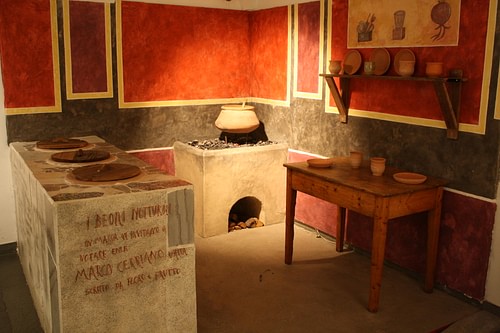
Dog Breeding, Training, & Collars
People of every class, however, admired dogs whether these were raised to guard a home or business, for hunting, racing, or as a pet. Dogs were quite popular among the Romans and the writer Columella (l. 4-70 CE), in fact, claims that a dog is the first purchase one should make after buying a home or establishing a business as it will serve to best protect one's interests. He also suggests keeping the dog's name simple (one or two syllables) so it will learn it easily and obey commands; advice dog trainers still give to owners in the present.
One of the most popular breeds was the Vertragus (ancestor of the modern Italian Greyhound) who was used primarily for racing and hunting because of its great speed and agility. Another popular breed was the Melitan, better known today as the Maltese, which slept on people's laps and so were known as lapdogs. Both of these breeds, whatever else their owners valued them for, were used as heaters to keep the owner warm. People, primarily women, kept the Melitan on their lap while Vertragus owners often slept with them, in winter especially.
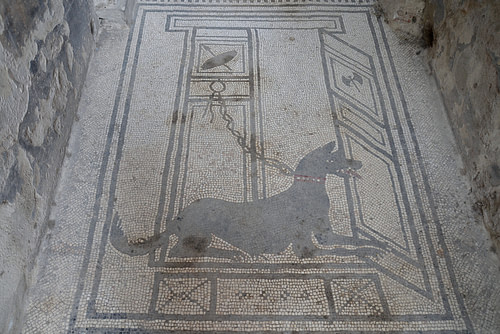
All the breeds wore collars, which were developed from Greek models but grew more ornate in time. The Vertragus wore a light-weight leather collar with a metal ring on it through which a leather thong-leash (the lyam) would pass so the dog could be controlled on walks, hunts, or before a race. The Molossian (probable ancestor of the Neapolitan Mastiff) was trained for war and outfitted with its own protective armor including a spiked collar. Scholars disagree on whether the Molossian was used in combat but there is ample evidence they were used to guard camps, as messengers, and to track opponents just as dogs are used by military forces in the present day.
Military & Religious Organization
Although it was not the first professional standing army in the world (that honor belongs to the earlier Assyrian Empire), the Roman military was the most efficient and powerful of its time and the Romans developed many aspects of military life still in use today. Basic training was mandated in order to instill discipline as well as skill in battle and use of arms. The Roman legions were equalitarian in that a soldier of the lowest class could rise through the ranks to become an officer. The Roman army had a corps of engineers, logistics and support staff, ordnance corps, communications divisions, and skilled medical support staff. The medics were so effective, in fact, that a soldier serving in the army of ancient Rome had a better chance of surviving his wounds than any who served in the American Civil War between 1861-1865 CE.
Roman religious beliefs and rituals were also influential on the later development of Christianity. Constantine the Great (r. 306-337 CE) dictated the foundational Nicene Creed in 325 CE which was adopted by the Catholic Church and, in sometimes modified form, by later Protestant churches. The concepts of the priest serving the deity personally, of transformation-through-ritual, appointment of priests by a board (the collegia), a High Priest and lesser priests, recitation of a religious ritual in Latin, and the use of incense in a worship service were all Roman traditions adopted by the Church, naturally, since Christianity was first officially recognized and promoted by the Romans.
Language & Leisure Activities
The Romans spoke Latin and this language spread to regions conquered by Rome in the same way that Roman architecture and overall culture did. The Latin language is the basis for the Romance Languages of French, Italian, Spanish, Portuguese, and Romanian, and many Latin words or phrases remain in use today or form the basis for English words. “School”, for example, comes from the Latin schola and “Island” from the Latin insula. Latin informs 80% of English, in fact, either as a root-word or directly and many Latin phrases are familiar to English speakers such as carpe diem (seize the day), bona fide (in good faith), per diem (by the day), and vice versa (one position switched with another) as well as many more.
The language spread long after the fall of the empire through Roman literature. Great Latin writers such as Ovid, Virgil, Horace, Juvenal, Marcus Aurelius, Cicero, Quintilian, and many others preserved the language and culture which would influence the works of later writers and the development of later languages.
Rome also developed the apartment building – known as an insula because it was like an island of its own in a city – and the city block – also called an insula. These apartment buildings had owners and landlords, running water and sanitation, just like apartment buildings today. In the summers, without air conditioning, it could be quite hot in Roman apartments and the people would go to public parks to swim and sit in the shade, just as they do today. They also enjoyed playing and watching sports, attending the theater, boating, swimming, and outdoor concerts.
Conclusion
The above are only a few of the many instances of the legacy of the ancient Romans. The practice of throwing rice at weddings comes from the Roman ritual of the bride and groom throwing nuts and sweets toward their guests who would then throw them back and toward each other. The groom carrying the bride over the threshold of their new home is also a Roman innovation. The Romans invented advertising and the concept of the billboard to promote their wares and invented the trademark through the practice of artisans stamping their name and/or seal on their work as a symbol of authenticity and quality.
The enduring legacy of the Romans should really come as no surprise, as noted by scholar Brian K. Harvey:
Over the course of a millennium, the Romans expanded from their small village on the banks of the Tiber River to eventually become the dominant culture in the Mediterranean basin. Even more than fifteen hundred years after their collapse, the Romans continue to captivate the imagination. Great works such as Vergil's Aeneid and the Colosseum in Rome continue to inspire new generations with a desire to learn more about the Romans and their lost culture. (xi)
Harvey is correct in his observation on the continual interest in ancient Rome but not about the lost culture. Roman culture was continued and, even in the present day, affects the lives of people all over the world, whether they know it or not. The organization of towns and city-planning, Latin phrases used in legal decisions, bureaucracy, standardized currency, the calendar, the public swimming pool, public library, civic centers and plazas, all come from the Romans. It is actually very difficult to imagine the modern world as we know it without the legacy of ancient Rome.
